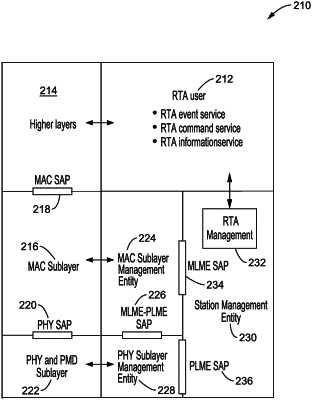| CPC H04W 80/12 (2013.01) [H04W 4/70 (2018.02); H04W 24/10 (2013.01); H04W 76/18 (2018.02); H04W 80/02 (2013.01); H04W 84/12 (2013.01)] | 24 Claims |

|
1. An apparatus for wireless communication in a network, the apparatus comprising:
(a) a wireless communication circuit for wirelessly communicating over a channel with at least one other wireless local area network (WLAN) station in its reception area;
(b) a processor coupled to said wireless communication circuit within a station (STA) configured for operating on the WLAN under IEEE 802.11 and utilizing an enhanced distributed channel access (EDCA) queue system; and
(c) a non-transitory memory storing instructions executable by the processor for providing a real-time application (RTA) interface between a medium access control (MAC) layer and application (APP) layer in an open systems interconnection (OSI) model to support interworking communications;
(d) wherein said instructions, when executed by the processor, perform steps comprising:
(i) operating said wireless communication circuit as a WLAN station configured to support communicating real-time application (RTA) packets that are sensitive to communication delays as well as non-real time packets and distinguishing real-time application (RTA) packets from non-real-time application (non-RTA) packets;
(ii) wherein said instructions are configured in an open systems interconnection (OSI) model having at least an application (APP) layer that generates and receives application data, a network layer that determines a route to an end-to-end peer wireless communication circuit and a next hop peer wireless communication circuit device, a medium access control (MAC) layer for controlling wireless media access protocols, a physical (PHY) layer for transmitting and receiving physical signals to the next hop peer wireless communication circuit;
(iii) creating new internetworking between network layers by creating an RTA interface between the MAC layer and Application layers, which provides the APP layer the ability to control and monitor MAC layer functions through a MAC layer management entity (MLME) so that RTA packets in the RTA session obtain low latency service, while non-RTA packets obtain random channel access under a conventional OSI model using carrier sense multiple access/collision avoidance (CSMA/CA) mechanism;
(iv) wherein upon starting an RTA session, after prior negotiation from the APP layer for establishing RTA connection-oriented communications, an RTA session identifier is created with information on type of service, source port and destination port; wherein when passed traffic from upper layers which is to be transmitted, the MAC layer extracts information embedded in the traffic and compares this with the RTA session identifiers to determine if this is RTA traffic and sends packets having a MAC header identifying the RTA session; and wherein the PHY layer upon receiving a packet checks its MAC header for RTA session information to determine it this is RTA traffic;
(v) generating a request by the application (APP) layer of the STA requesting the MAC layer to start a new session with a given set of requirements;
(vi) monitoring the channel by the MAC layer and obtaining key performance indicators (KPIs) to derive a response to the APP layer;
(vii) either accepting or rejecting the request to start a new session by the APP layer by the MAC layer according to the RTA session requirements and measured KPIs; and
(viii) reissuing the request to start a new session by the APP layer with adjusted parameters if the new session initiation gets rejected.
|